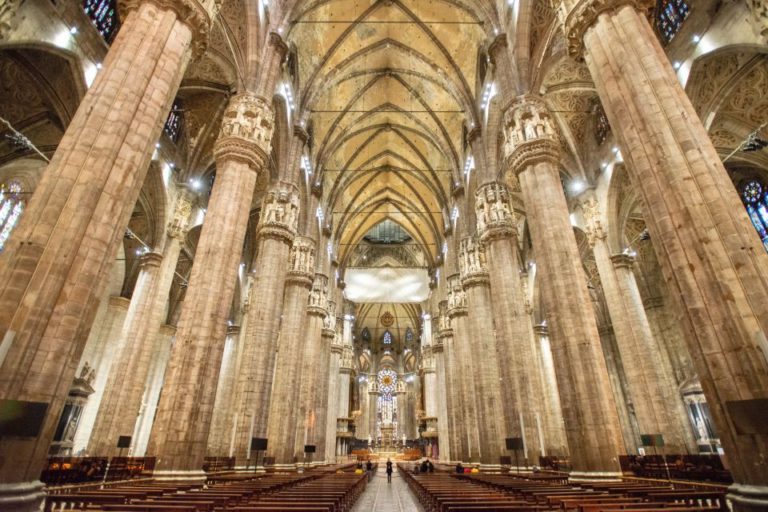About Duomo Milan
Nestled in the heart of Milan, the Cathedral of Milan is a magnificent structure that showcases a harmonious blend of Gothic and Renaissance architectural styles. One of the largest Gothic cathedrals in the world, it attracts millions of visitors each year who come to admire its breathtaking views of the city and learn about its rich history and architecture.
Information about the Cathedral of Milan:
- Name: Cathedral of Milan
- Location: Piazza del Duomo, 20122 Milan, Italy
- Opening Date: January 6, 1965
- Operating Hours: Open daily from 9:00 AM to 7:00 PM
- Architects: Simone da Orsenigo and others
- Architectural Style: Combination of Gothic and Renaissance styles
- Annual Visitors: Approximately 5 million people.
What is the Duomo di Milan?
The Duomo di Milan, also known as the Duomo Milan Cathedral, is a well-known landmark situated in the heart of Milan. It showcases a magnificent example of the northern Gothic style found in Italy, with its towering spires and columns standing tall in the Piazza del Duomo Milan. The exterior of the cathedral is characterized by its elaborate sculptures, pointed pinnacles, and soaring buttresses.
With the ability to accommodate up to 40,000 individuals, the Duomo di Milan is one of the largest Catholic churches globally, possessing a rich historical interior, a beautiful atmosphere, and a unique charm that makes it a must-visit destination.
Why is the Duomo Milan So Famous?
The Duomo di Milano is recognized as the 5th largest church in the world and can accommodate up to 40,000 individuals. It is a masterpiece that was created by the collaboration of various legends in architecture and design across 9 generations. Over 500 years, thousands of artists, craftsmen, and builders from all over Europe worked together to construct this magnificent cathedral.
The Duomo di Milano is renowned for its unique blend of different architectural styles, including Gothic Revival, Romanticism, Flamboyant Gothic, and Gothic, showcasing the works of various legendary artists from different periods. Its impressive collection of 4000 statues, gargoyles, and figures adds to its fame.
Visitors can also witness the Holy Nail relic, which according to legend was used in the crucifixion of Jesus Christ. The red light bulb that illuminates the altar creates a striking impact.
Climbing up to the terrace offers stunning views of the city and a chance to see the 135 spires rising high above the cathedral. Another fascinating feature is the sundial located near the main entrance, which was once used to regulate the clocks throughout the city.
Finally, the gilded statue of Madonnina and the Virgin Mary, situated on the highest spire of the Milan Cathedral, is a magnificent sight that draws many visitors.
Who Built the Duomo Milan?
The Duomo Milan was built by a team of 78 architects, including notable names such as Pellegrino Tibaldi, Donato Bramante, Giovanni Antonio Amadeo, Cristoforo Solari, Giulio Romano, Francesco Maria Richini, Bernardo Zenale, Francesco Croce, and Andrea Biffi.
The History of Duomo Milan
In 1385, the decision was made to replace the existing cathedral in Milan with a new one, commissioned by Giangaleazzo Visconti. Work on the cathedral began in 1386, but it was soon halted due to a lack of funds and creative direction.
In 1805, Napoleon Bonaparte provided financial support for the construction, which allowed for the completion of the cathedral’s pinnacles, spires, flying buttresses, and roof. Stained-glass windows were installed between 1829 and 1858 to replace the original ones.
In 1943, the city of Milan was bombed, damaging the cathedral, which required repairs. The construction of the cathedral was finally completed in 1965 and opened to the public.
The Architecture of the Duomo Milan
The Duomo Milan, or Milan Cathedral, is a famous Gothic cathedral that incorporates elements of Renaissance architecture. The construction of the cathedral took place over several centuries and its design evolved as technology advanced in Europe.
The façade is constructed of marble and features different styles of architecture, with the lower levels following Renaissance design and the upper levels exhibiting Gothic design. The cathedral boasts over 3400 statues, thousands of spires, and the tallest spire standing 354 ft. tall with a gilded statue of the Virgin Mary known as La Madonnina.



